Simple English Style Scones
These English Style Scones bake up light, soft, and fluffy, and are a wonderful treat for breakfast or afternoon tea. Spread them with jam, clotted cream, butter, or simply eat them plain. They’re incredibly delicious and are made in 25 minutes. No chilling required!

English style scones are wonderfully light, soft, and fluffy, and this recipe uses a simple no chill method with softened butter to create that signature tender texture. Made with flour, butter, milk, and eggs, the dough comes together quickly in the food processor and bakes into warm, pillow soft scones that are ready in about twenty five minutes.
I grew up eating incredible scones from a beloved Bay Area bakery called Sconehenge, and I spent years trying to recreate that perfectly soft texture after moving away. Nothing ever came close until a trip to England, where I tasted an English style scone and finally understood what made those childhood scones so special. After years of practice, this recipe is now my go too and same with hundreds of my readers that say this is the best scone recipe they have ever made!
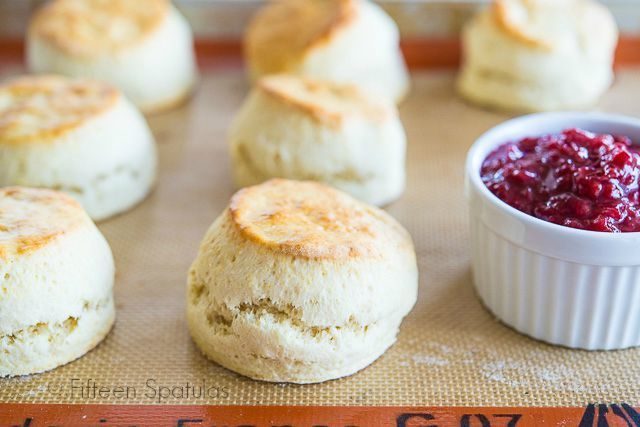
English scones are made differently from American scones, and instead of being stiff and dry, they’re fluffy and soft. A lot of people think these look like American biscuits, and they kind of do, but they’re prepared quite differently.
Best Practices for Baking Scones
Work quickly, and resist the urge to add excess flour – I paired these two tips together, because they really go hand in hand. You’ll want to have all your ingredients ready to go so that you can carry the recipe out quickly, because the butter will only get warmer and the dough stickier if you take too long.
Push the cutter straight down – When you go to cut your circles of scone dough, make sure to push the cutter straight down. Do not twist the cutter. This will ensure the scones rise as high as possible.
Use the best quality butter – It’s incredible how different brands make wildly different tasting butters. Some don’t taste like much of anything, while others have incredibly rich flavor, that slightly sweet dairy fat flavor all humans love. My favorite butter is Kerrygold. Plugra and Vermont Creamery also make great butter. If you look up butter taste tests online, you’ll see that they are definitely not all equal.
Use fresh baking powder – Baking powder is what helps these scones rise, so if your baking powder has been sitting for more than 6 months, it likely has lost its full effectiveness! New and fresh baking powder is going to give you best results.
Ingredients for Big Fluffy Scones
All Purpose Flour – Creates the perfect dough
Baking Powder – Makes the scones rise (Use fresh!)
Salt – Balances flavor perfectly
Sugar – Adds slight sweetness you look for in a scone
Softened Butter – Softened butter turns the flour into a sandy texture dough we need
Whole Milk – Perfect fat content for moisture and holds everything together
Egg – Adds structure for a fluffy scone
How to Make Perfect Scones: A step by step guide
- To get started, combine all-purpose flour, salt, baking powder, and sugar in a food processor, then add softened butter:
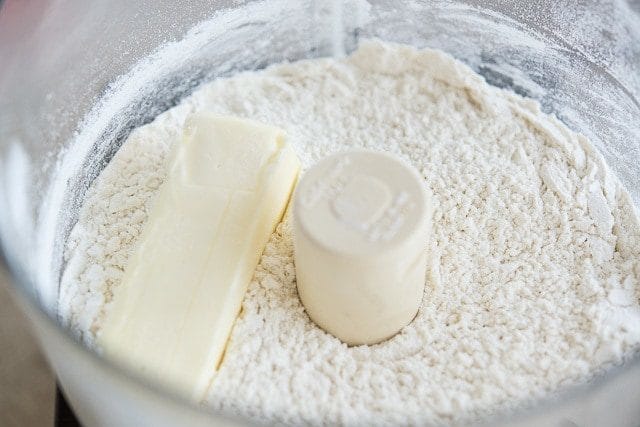
- Pulse the food processor ingredients until the softened butter is well incorporated into the flour.
Note: if you are using a pastry cutter, you’ll need to work it through til is has this sandy texture
You can see that unlike a pie crust, we don’t have big pieces of butter in the flour. Rather, it has a sandy, soft texture:
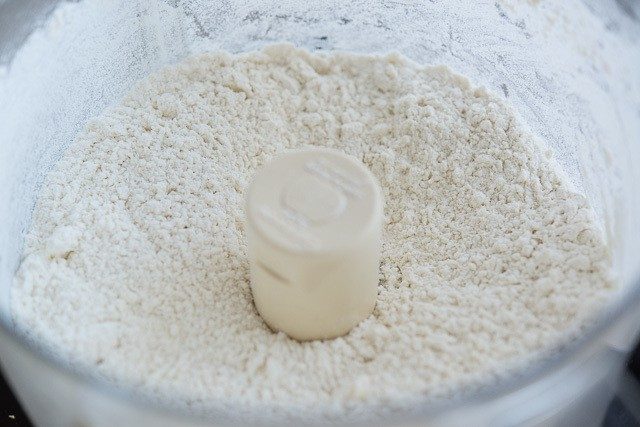
- Dump this mixture into a large bowl.
- In a seperate bowl whisk together your milk and an egg, saving 2 TBSP of this egg wash in a small bowl for later.
- Add the rest of your milk and egg mixture into your flour mixture
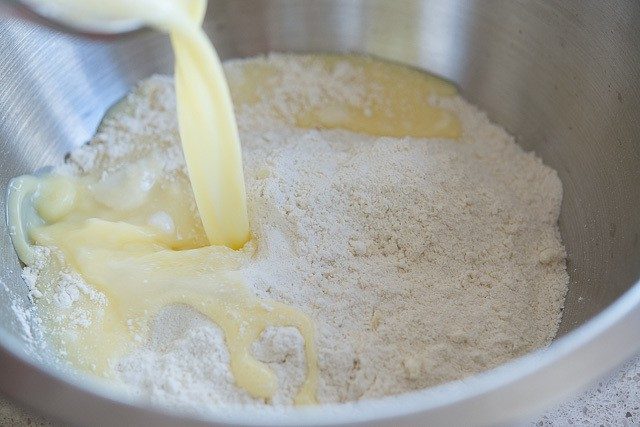
- Stir together with a spatula, then when it’s roughly combined, dump it onto a lightly floured surface:
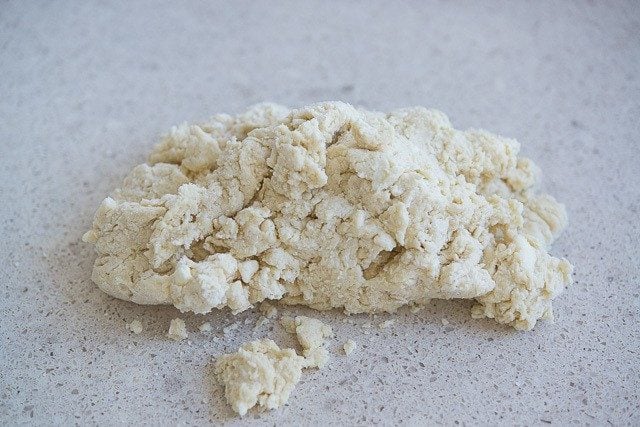
- Lightly flour the dough, then knead it until it smooths out a bit, just a few times:
Note: this mixture will be wet. Resist the urge to add too much excess flour, this will make your english scones drier.
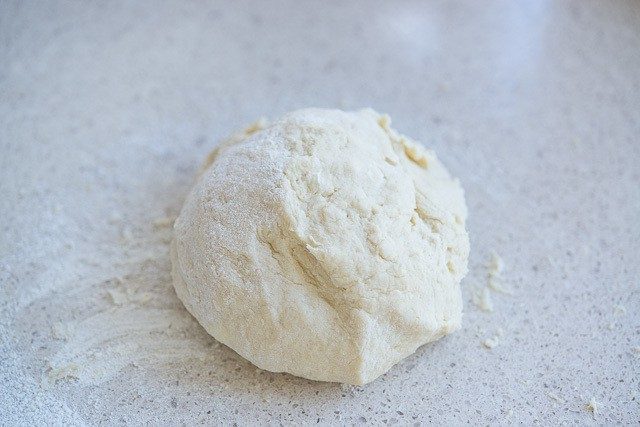
You can see that it’s still sticky, and there are bits sticking to my counter. Again, this is important for a hydrated dough, a soft texture, and good rise. As with anything where you combine flour with liquid, try not to knead too much, or excess gluten will develop and make the scones tough, and also prevent them from rising as high.
- Roll the dough about an inch thick:
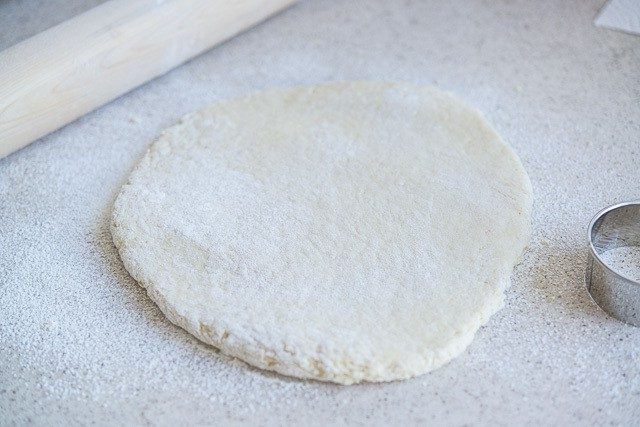
- Use a 2.5″ cutter to cut circles, or, use a sharp knife to cut square pieces. Then place them on a silicone mat or parchment paper lined baking sheet.
Note: Make sure not to twist the cutter at all when cutting the circles. Push straight down toward your work surface, otherwise they won’t rise as tall.
- Before baking, brush each scone circle with the reserved egg milk wash:
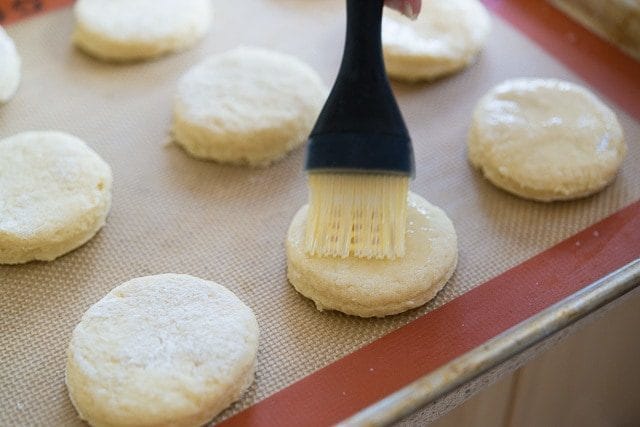
- Bake 13-15 Minutes at 425°F until lightly golden on top
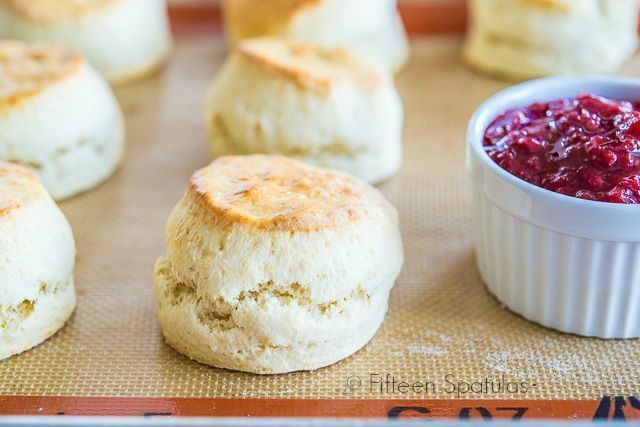
How to Serve Scones
Serve the scones while they’re warm with your favorite jam (I love this strawberry jam) and clotted heavy cream for extra bonus points. My grocery store sells this in the fancy cheese section. Butter is of course lovely too, especially Homemade Orange Honey Butter.
You can certainly enjoy these after they’ve cooled as well, but like many baked goods, they are always at their peak when they’re fresh and warm out of the oven. I love these for Mother’s day, baby showers, and weekend brunches.
For your next homemade baking projects, I also suggest these Homemade English Muffins, my favorite Banana Bread, and Pumpkin Muffins.
Flavor Additions and Substitutions
Here are a few easy ways to experiment with different flavor combinations. This is a great recipe for playing around with variations, and can be looked at as a master scone recipe of sorts.
Citrus zest: If you’d like to add orange zest or lemon zest, those additions work beautifully. Add up to 1 tablespoon of zest to the flour mixture.
Dried fruits: Add up to 1 cup of your favorite dried fruit after you’ve combined the wet and dry ingredients, but before all the flour has moistened. Blueberry scones made with dried blueberries are one of my favorites. Dried cherries are also wonderful.
Crunchy sugar: For an exterior crunch, sprinkle on a little sugar to the tops of each scone after brushing with egg wash. Turbinado sugar has great texture.
Chocolate chips: Add up to 1 cup of your favorite chocolate chips after you’ve combined the wet and dry ingredients, but before all the flour has moistened.
What about fresh fruit? This is possible, but I issue a caution. Add up to 1 cup, but know that fresh fruits are trickier because they tend to be wet, and this is already a fairly wet dough. Adding fresh fruit makes the scone dough more challenging to work with.
FAQ and Troubleshooting
At room temperature, for a few days. In the fridge, for a couple weeks. In the freezer, a few months. Because there are only simple ingredients here and no preservatives, the scones will mold if left out for more than a few days.
You can either freeze scones baked or unbaked. To freeze baked scones, let them cool to room temperature, then freeze in an airtight bag for up to 3 months. To freeze unbaked scones, make the recipe up to cutting the dough circles, then bake the circles straight from frozen for 5 extra minutes, or until cooked through.
Bake in a 300F oven for 5-10 minutes, until warmed through. You can also cut them in half and toast them. Add a few extra minutes if reheating from frozen.
Yes. Like any baked good, these are best fresh, but they’re still fantastic the next day. Reheat them per the instructions above, or bake from frozen (instructions are in the post).
As noted above, it’s normal for the dough to be a little bit sticky, but it should still be workable. If it’s not workable, this is probably either because there’s not enough flour, or the butter got too warm. So first, try to weigh the flour if possible. There is already so much variation between cup measuring and brands, and weighing the flour will help ensure proper proportions. Next, try to assess if the dough needs more flour, or if it’s too warm. For example, if the butter you used is softened above 70 degrees F (or if you used the microwave softening feature for a bit too long), the butter may be too warm by the time you’re working with it. Popping the dough into the fridge will firm the butter slightly, and may help you roll it out. Or, you can add just enough flour to the outside to roll it out, then cut the pieces.
First, make sure you’re using fresh baking powder, one that has been opened less than 6 months ago. Also, if you knead the dough too much, the scones won’t rise as tall. Knead gently, and just enough to bring the dough together. Adding more flour also prevents the dough from rising as high, so only dust lightly.
Tried this recipe? Leave a rating and comment below — I’d love to hear how it turned out! Or, follow me on Facebook, Instagram or Pinterest!
Here’s a video I made for the scones, follow along with me and ill show you all the details
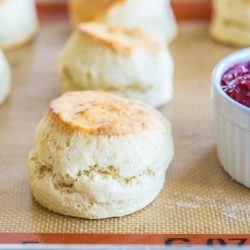
English Style Scones Recipe
Ingredients
For the Scones:
- 2 cups all-purpose flour (10 ounces by weight)
- 4 tsp baking powder
- 1/2 tsp salt
- 1/4 cup sugar
- 6 tbsp unsalted butter at room temperature
- 2/3 cup whole milk
- 1 large egg
Instructions
- Preheat the oven to 425 degrees F.
- In a food processor, pulse the flour, baking powder, salt, and sugar a couple times to combine.
- Add the butter and pulse 7-10 times until the butter is completely distributed. You shouldn’t see any chunks of butter, and the mixture should have a sandy texture to it. Transfer to a large mixing bowl.
- In a small bowl, whisk to combine the milk and egg. Save 2 tbsp of it for the egg wash later, and pour the rest into the mixing bowl with the dry ingredients.
- Stir to combine with a spatula, until a rough dough forms.
- Transfer to a lightly floured countertop and knead about 10 times until the dough comes together into a relatively smooth ball. Take care not to knead too much, or the dough will be tougher and not rise as high.
- Roll the dough about an inch thick and use a 2.5″ cutter to cut about 7 circles. Re-roll the scraps and cut out another 2.
- Place the scones onto a parchment or silicone mat lined baking sheet and brush the tops with the reserved egg wash.
- Bake the scones for 13-15 minutes, until about tripled in height, and golden brown on the tops and bottoms. Enjoy!
Notes
Nutrition
Nutrition is estimated using a food database and is only intended to be used as a guideline for informational purposes.

610 Comments on “Simple English Style Scones”
I recently made blackberry preserves. As soon as I tasted it thought, “this would be amazing on English scones with clotted cream.” I’ve never made scones before, but these are EXACTLY what I was after! Well definitely be baking them again.
Where the Bezzy comes from I don’t know. It is Bess
Well, the first time I tried surprise my husband with scones, they were so hard and dry that we could have used them as missiles!! I never tried again for 50 years until now. This recipe is marvelous, soft and moist and my daughter raved about it. It keeps very well in the fridge. Next double batch is going to be for morning tea at church. Thanks for sharing this marvelous recipe! Regards, Bezzy
Yay! Thanks Bess, im so glad you gave them a try again. they are so yummy
Great recipe. Many good recipes on this site. Thank you.
Thanks Janice!
Just made these for the firstvtime and they were great. Will make this again.
Thanks Lisa! So glad you enjoyed them
I am English and have tried for years to make the perfect English scone. I am so glad I found your recipe because they turn out perfectly every time. I add raisins to mine and they are so tasty that we don’t even bother with jam and butter..
Thanks Pauline! So glad you are enjoying these
Can you use 2% milk?
I dont recomend it, The scones really need the extra fat content
Just like I had in the UK,
Can you make the dough ahead of time, refrigerate overnight and bake the following morning?
I made these and they did not triple in height. Very disappointed
First, make sure you’re using fresh baking powder, one that has been opened less than 6 months ago. Also, if you knead the dough too much, the scones won’t rise as tall. Knead gently, and just enough to bring the dough together. Adding more flour also prevents the dough from rising as high, so only dust lightly.
I made these for a fundraiser for the pollinators at our organic farm. We had a Monarch Tea. These scones were perfect with some clotted cream and jam! I doubled the recipe, used cold butter and fresh baking powder. They turned out great.
yay! Thanks Barb!